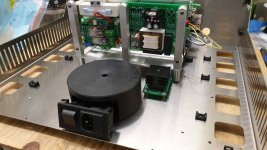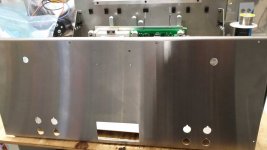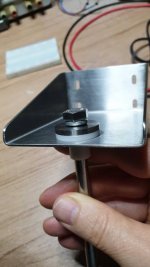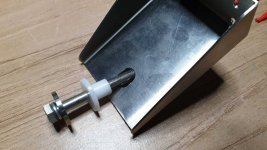There are no pcb boards available!???
I might have some left. I'll have a look tonight.
I still have a few Slewmaster output boards and some Spooky input boards.
That is a premiere combination! And well worth the build.
Beautiful! What's all them boards you have?Finally getting somewhere with this build. Its only taken me 3 years. Lol.
View attachment 742095View attachment 742096View attachment 742097View attachment 742098View attachment 742099View attachment 742100View attachment 742101
Finally getting somewhere with this build. Its only taken me 3 years. Lol.
View attachment 742095View attachment 742096View attachment 742097View attachment 742098View attachment 742099View attachment 742100View attachment 742101
You need to drop the top bracket on the the transformer. It's gonna form a grondloop and give you hell..
It's fine. Its completely isolated from the bolt running through the center of the transformer.You need to drop the top bracket on the the transformer. It's gonna form a grondloop and give you hell..
Unless there's another reason that you could provide some more information on.
Thanks for the heads up.
Last edited:
Why do you need to use that bracket on top of the transformer?
It *might* create a shorted turn in the transformer.
It *might* create a shorted turn in the transformer.
No contact with the disk either, that's why the insulating bush is longer so it passes through the disk as well.Okei. so no contact between the bolt, transformer disk and bracket?
The reason for the top mount is.
I was a little short on space in my case so I lifted the transformer up a bit to give me room for my IEC plug.
It sits on top of the black plastic block.
The top bracket prevents any vibrations in the transformer as it holds it more securely.
There is also a welded in threaded bush in the bottom of the case so I don't have to worry about holding a nut while I tighten the through bolt.



You are out of control Stuart!No contact with the disk either, that's why the insulating bush is longer so it passes through the disk as well.
The reason for the top mount is.
I was a little short on space in my case so I lifted the transformer up a bit to give me room for my IEC plug.
It sits on top of the black plastic block.
The top bracket prevents any vibrations in the transformer as it holds it more securely.
There is also a welded in threaded bush in the bottom of the case so I don't have to worry about holding a nut while I tighten the through bolt.View attachment 761921View attachment 761922View attachment 761923
It looks beautiful and well thought out. You will have a lot of spare time when you finish it. [emoji1787]
Question on heatsinking
Hi. I am planning to build the honey badger amplifier and I would like to know whether this heat sink would be able to dissipate enough power to keep the transistors cool or not.😕
Heatsink extruded, grilled, L 150mm, W 262mm, H 60mm, aluminium - 27.44 EUR : acdcshop.gr - Online shopping
Hi. I am planning to build the honey badger amplifier and I would like to know whether this heat sink would be able to dissipate enough power to keep the transistors cool or not.😕
Heatsink extruded, grilled, L 150mm, W 262mm, H 60mm, aluminium - 27.44 EUR : acdcshop.gr - Online shopping
that would be more than enough. i'm planning on a 160x300mm and 30mm high pr channel for my 5 ch honeybadger amp🙂
Also, one more question: is it worth creating a dual mono arrangement or is it better to supply power to both channels with a common power supply?
Most amps will have a better "stereo image" with separate supplies for each channel. No cross talk between channels.
Would it be better to have 2 separate transformers or one transformer with 4 secondaries (2 for the left and 2 for the right channel). They are both dual mono since each channel is isolated from the other, aren't they? Also, in the build guide it states that the recommended filtering capacitance per rail is 40000uf. If I decide to use dual mono arrangement, would 20000uF or 30000uf per rail for each channel be enough?
Both would basically be the same. I find dual transformers easier to fit in a chassis due to the smaller diameter.
Randy Slone's rule of thumb was 10000uF / rail / 100W output power. 20000uF per rail is pretty standard for this power level.
Randy Slone's rule of thumb was 10000uF / rail / 100W output power. 20000uF per rail is pretty standard for this power level.
- Home
- Amplifiers
- Solid State
- diyAB Amp The "Honey Badger" build thread

